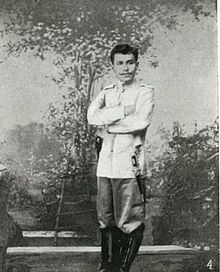Tomás Mascardo
The Honorable Tomás Mascardo | |
|---|---|
 | |
| Governor of Cavite | |
| In office 1910–1912 | |
| Preceded by | Leonardo Osorio |
| Succeeded by | Antero Soriano |
| Governor of Pampanga | |
| In office 1899–1899 | |
| Preceded by | Tiburcio Hilario |
| Succeeded by | Francisco Dizon |
| Member of the Malolos Congress from Zamboanga | |
| In office September 15, 1898 – November 13, 1899 Serving with Felipe Buencamino and Lazaro Tanedo | |
| Personal details | |
| Born | Tomás Mascardo y Echenique October 9, 1871 Cavite El Viejo, Captaincy General of the Philippines, Spanish Empire |
| Died | July 7, 1932 (aged 60) Cavite, Philippine Islands |
| Spouse(s) | Carmen Topacio |
| Children | 8 |
| Parent(s) | Valentin Mascardo (father) Dolores Echenique (mother) |
| Military service | |
| Allegiance | |
| Branch/service | |
| Rank | |
| Battles/wars | Philippine Revolution * Battle of Zapote Bridge Philippine–American War |
Tomás Echenique Mascardo (born Tomás Mascardo y Echenique; October 9, 1871 – July 7, 1932) was a Filipino general during the Philippine Revolution and Philippine–American War. He joined the fight against the Spaniards since the start of the revolution. He later became a one-term governor of Cavite from 1910 to 1912.
Biography[]
Early years[]
Tomás Mascardo was born in the town of Cavite del Viejo (now Kawit) to Valentín Mascardo and Dolores Echenique. The affluent couple, a landowner and a rice dealer, respectively, had a total of seven children. Tomás finished his teacher's diploma from Escuela Normal in Manila and became a teacher at the barrio school of Halang in Amadeo, Cavite.[1]
Philippine revolution[]
Mascardo joined the revolution against the Spaniards from the beginning. He became the chief of the revolutionary intelligence service in Manila, succeeding Miguel Liedo who was captured and sentenced to death by the Spaniards. He was ordered by General Emilio Aguinaldo to attack a Spanish stronghold in Tanauan, Batangas, where the general was awed by Mascardo's courage. In time, he was promoted to brigadier general. Mascardo, together with his commander, General Edilberto Evangelista, fought at the Battle of Zapote Bridge on February 17, 1897 where Evangelista was killed and Mascardo wounded.[1]
Philippine–American War[]
During the Philippine–American War, Mascardo was assigned as commanding general of the revolutionary forces in Pampanga, Bataan, and Zambales provinces with barracks in Bagac, Bataan. Following Aguinaldo's capture by the Americans on March 23, 1901 in Palanan, Isabela, he ordered his subordinate, Major Manuel L. Quezon, to surrender as well so he can verify the capture and if so, consult Aguinaldo for final orders as there was also an order for Mascardo to surrender. Quezon was able to meet Aguinaldo in a room at the Malacañang Palace where he was detained. After relaying Mascardo's message, Aguinaldo instructed Quezon that the decision to surrender is up to Mascardo himself. Mascardo surrendered on May 15, 1901, calculating that his deficiency in weaponry would mean sure defeat from the well-armed Americans.[1]
Political career and death[]
Mascardo returned to Cavite following his release by the Americans. He was influenced to enter politics, and won the gubernatorial seat of Cavite, a post he held from 1910 to 1912. He retired and lived a private life after only one term. On July 7, 1932, he died from a heart disease.[1]
Personal life[]
Tomás Mascardo was married to Carmen Topacio of Imus, Cavite. The couple had eight children – Modesto, Dominador (who became a general), Petra, Pura, Jaime, Tomás, Salvador (a former collector of customs at the Manila International Airport), and Emiliano.[1]
In popular culture[]
- Portrayed by Allan Paule in the film, El Presidente (2012).
- Portrayed by Lorenz Martinez in the film, Heneral Luna (2015).
References[]
- Quirino, Carlos. Who's who in Philippine History. Manila: Tahanan Books, 1995.
- 1871 births
- 1932 deaths
- Filipino generals
- People from Kawit, Cavite
- Tagalog people
- People of the Philippine–American War
- People of the Spanish–American War
- People of the Philippine Revolution
- Filipino rebels
- Governors of Cavite
- Members of the Malolos Congress
- Governors of Pampanga